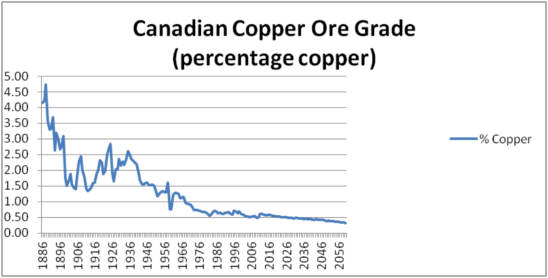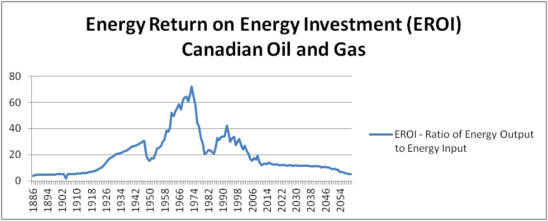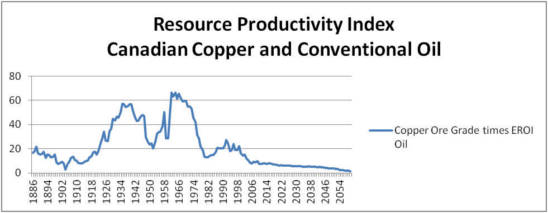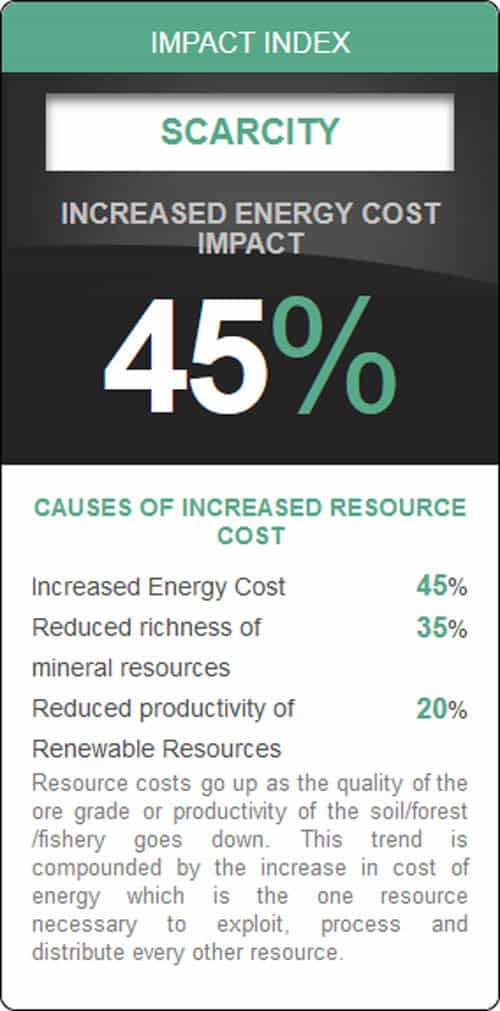Resource Scarcity: An Overview
The Impact Of Oil Depletion On Our Environment And Economy
The overexploitation of natural resources is a tale as old as time, and humans have always exploited the most accessible and richest resources first. The deepest and most fertile soils, the tallest, straightest trees and the most mineral laden ore bodies were the first to be harvested.
In a world of virgin resources, resource depletion was not yet a concern. Early agriculture in the golden triangle took place upon meters of rich alluvial soils. Timbers were drawn from towering stands of old growth forests. Metals were melted from outcroppings of ore by lighting fires beneath them. Fish were harvested by the basket.
Over time, we’ve had to search further for the resources we need and work harder once we found them. That leaves us with a trend of using poorer and poorer sources for the material necessities of life, leading to resource depletion. Although most of the richest resources on the planet were being used and reduced by the middle of the 20th century it was an easy problem to ignore.
The reason for this burgeoning resource scarcity was one simple word: oil- code for cheap, dense, flexible energy.
Oil Depletion And Its Effects
Oil has allowed us to exploit every other resource to a far greater point of depletion than would have been possible with any other form of energy. It is the uber-commodity, without which our way of life cannot exist.
Now that oil scarcity is making it more expensive to produce, the richness of the other resource bases upon which we depend is becoming much more obvious. Oil depletion causes us to rely on other resources, making resource scarcity an increasingly broad problem.
Oil Scarcity: Quick Facts
The lower the grade of ore (say ounces of mineral per tonne of rock), the more rock must be processed to obtain the mineral.
- In Canada in the late 1800s, the average yield of copper per tonne of rock was 90 pounds or 4.5%.
- In 2016, the average copper mine was working with an ore grade of 0.5%.
- This requires 9 times the amount of rock to be processed, involving many times the expenditure of energy.
If energy costs are low and falling, resource depletion is not a critical problem. However, oil has ceased to be almost free. 40 years ago, the biggest and richest reserves of oil in the Arabian peninsula and West Texas required one barrel of oil to discover and extract 100 barrels of oil.
- This was an energy return on energy investment (EROI) of 100:1.
- Current world oil production is averaging EROIs in the region of 15 to 20:1.
- Oil sands and fracked oil EROIs are barely 5:1.
- The EROI of wind energy is in the neighbourhood of 12 to 14:1
- Solar EROI is typically around 8:1
Oil scarcity causes higher energy costs, meaning that every other resource automatically faces scarcity and higher costs as well. To avoid resource scarcity, sustainability, on the other hand, means much greater conservation of renewable resources and much lower levels of consumption of minerals.
Resource Scarcity and the Human Effort Index
The level of effort required by humans to harvest resources in their raw form and process them into finished goods determines our material standard of living. If the raw resource is easily accessible and rich, then it requires little of our time to acquire it. If the resource is rare and difficult to obtain, then it requires a lot more effort on our part to obtain useful amounts of it. In other words, resource depletion is directly related to accessibility.
Take copper, for instance. Being a critical ingredient in electrical components, it is a vital commodity without which an advanced human society cannot exist. Fortunately, copper is relatively abundant.
In ancient times, humans built fires under rocks containing high percentages of copper and the melting ore simply flowed onto the ground. But those few rich outcroppings of natural resources were quickly subject to overexploitation, and after that humans had to expend more and more effort to work increasingly poor ore bodies.
Then came the discovery of oil and the development of technology and processing, which allowed humans to access ore bodies virtually anywhere in the world and with much lower contents of ore. Why? Because oil became very easy to produce, and it contained an incredible amount of energy which we found very easy to apply in thousands of ways. This ease of accessibility began paving the path for resource depletion.
Oil is a non-renewable mineral as well, and is available in many different forms in reserves requiring many different levels of effort to exploit. In the glory days of the resource, the richest fields of West Texas and the Middle East required only one barrel of oil energy input to yield 100 barrels of output. The EROI, or Energy Return On (Energy) Investment, was 100:1. In the period of the 1930s to the 1950’s real energy costs were falling and supply seemed limitless.
But now in the early 21st century, the easiest and richest of these natural resources have undergone exploitation and any future sources will require increasing effort to extract. The energy required to produce oil from oil sands or tight oil (fracking) reserves is vastly more than the large conventional fields of Texas and Saudi Arabia. In these new, unconventional reserves, one barrel of oil worth of energy will only yield between 4 and 5 barrels of oil for an EROI of 4 or 5:1.
For a reserve with an EROI of 100:1, the net amount of oil produced by 1 barrel of input is 99 barrels output. For a reserve with an EROI of 5:1, the net output per barrel input is 4 barrels, so theo net EROI is 4:1 In 1950, only 1% of energy from oil was used to discover and produce more oil. In the decades to come, over 20% of the energy we produce will have to be used to produce the energy we consume. This is the impact of oil depletion, and we will see the same outcome in the overexploitation of any natural resources.
Resource Depletion: Long Term Impact
What are the implications for humanity of resource scarcity and the declining productivity of the basic resources bodies upon which our societies are built?
Consider the graph below which illustrates the richness of copper ore grade mines in Canada from the late 1800s to present day. This provides us with a clear picture of resource depletion and its impact over time.
Clearly, the average ore grade is much lower now and clearly, much more effort (and energy) is required to extract copper than was the case 100 years ago. In the late 1800s, copper ore mined in Canada had close to a 4% content of copper. In 2010, the average content was close to 0.5% or less than 15% of what it once was. Going forward, the yields are likely to decline gradually.

Looking at Canadian oil reserves, we see a similar long term profile of resource scarcity. As the richer and more accessible reserves were exploited and exhausted, average yield (EROI) has fallen. Canadian conventional oil fields were much smaller and not as rich as those in the Middle East and therefore have “played out” much more rapidly.
Resource Scarcity And The Alberta Oil Sands
The development of the oil sands in Alberta will see large amounts of oil being produced over the next century, but the oil output will require a much higher energy input. The EROI for the oil sands is in the area of 5:1, which dictates a much higher human effort and higher environmental cost. Oil scarcity due to the overexploitation of natural resources comes at a high price, both economically and environmentally.
Moving forward, the proportion of oil produced from conventional reserves with higher EROIs will decline as those fields play out, and the proportion from the oil sands with its lower EROI will increase. In short, we are moving into the era of more expensive energy. In this way, oil depletion will drive up the costs of energy more quickly than most would like to think.
Below is a graph showing the ratio of energy out per unit of energy in for Canadian oil and gas. Although the fields were small and output declined quickly, the EROI hit a very respectable 70:1 in the early 1970s. As output from the much lower EROI oil sands comes to dominate, the overall EROI is dropping continuously, indicating the long term impact of oil scarcity.

The primary energy used to mine copper in Canada is oil/gas and below is the combined productivity index for Canadian copper.

Inverting Resource Productivity Index to illustrate the human effort involved, we have the chart below.
Natural resource scarcity drives both human effort and long term costs. Human effort was greatly reduced when the ore body was rich and when the energy supply was cheap and plentiful. As both resources have become more scarce, we can see moving forward that real output of most resources, illustrated by copper as the end product, has required increasing human effort. Technology may flatten this curve slightly, but technology to date is fully represented in these charts. The bottom line is that real costs have gone up due to resource scarcity, and they will continue to do so.

Other resources will have different curves but they are all heavily modulated by energy. Very few show a declining Human Effort Index. As effort and costs continue to rise, the impact of resource scarcity will become more keenly felt.
In the 150 years from the early 1800s to the late 1900s, which saw western society’s massive expansion of population, consumption and expectations, energy was continually getting cheaper and more abundant. New resource bases were regularly being discovered and the overexploitation of natural resources was commonGoing forward, the physical reality of declining resource bases means our methods of development and production will be changing- as must our expectations.
- Wake Up Amerika – Our industrialized existence
- The Globe and Mail – Disappearance of cheap oil
- elsevier.com – This raises the spectre of ‘peak minerals’ – the time at which production from terrestrial ores can no longer rise to meet demand and where a maximum (peak) production occurs.
- Green Leaf Publishing – Why resources are back on the agenda
- Gavin Mudd – Overall, the key trends are declining ore grades versus increasing metal production and ore milled, and increased open cut mining and associated waste rock
- Springer – Human societies face a threatening future of resource scarcity and environmental damages. This book addresses the challenge of turning these risks into opportunities and policies. It is a collection of high level contributions from experts of sustainable growth and sustainable resource management.
- Gavin Mudd – What are the costs in terms of energy, pollution, greenhouse gas emissions, water, land use impacts, social impacts, economic aspects associated with this globally important industry?
- WAU – Non-renewable natural resources – more but not enough
- UGUS Open File Report – Energy Required for Resource Exploitation
- Mining Journal – Copper – Changing copper yields and grades
- Gavin Mudd – We compile and analyze a range of data on uranium mining and milling, including uranium resources as well as sustainability metrics such as energy and water consumption and carbon emissions with respect to uranium production
- Gavin Mudd – Metallic ore grades are falling globally as the higher grade reserves are exploited first and are progressively depleted.
- Gavin Mudd – A major strategic issue for all sectors of the global mining industry is the use and management of water resources
- Encyclopedia of Earth – Gold Mining and Sustainability: A Critical Review
- Gavin Mudd – It is important to recognise the links between gold production trends and resource intensity, as this is critical for understanding future sustainability challenges.
- Lead Action News – The Arrival of Peak Lead: Peak Environmental Impacts
- Gavin Mudd – Our increasing population size and per capita impacts are severely testing the ability of Earth to provide for peoples’ most basic needs.
- Gavin Mudd – There is an increasing amount of Ni being mined from laterite ores—leading to increasing energy and greenhouse gas emission costs for Ni production
- Minnesota – The peak of world oil production, followed by an irreversible decline, will be a watershed in human history. The goal of this paper is to predict the world peak
- elsevier.com – Metallic ore grades are falling globally as the higher grade reserves are exploited first and are progressively depleted
- Yale – Phosphate has been essential to feeding the world since the Green Revolution, but its excessive use as a fertilizer has led to widespread pollution and eutrophication. Now, many of the world’s remaining reserves are starting to be depleted.
- Wake Up Amerika – Increasing Global Nonrenewable Natural Resource Scarcity
- UN – Soaring Demand for Metals Calls for Rethink of Recycling Practices, Says International Resource Panel
- Business Insider – Grantham concludes that the world has undergone a permanent “paradigm shift” in which the number of people on planet Earth has finally and permanently outstripped the planet’s ability to support us




